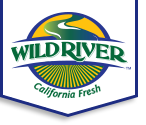Origination
Originally named “Chinese Gooseberry” the kiwifruit is borne from a woody vine of the genus Actinidia that grows wild along the banks of the Yangtze River Valley in northern China. Cultivation of green kiwi (Actinidia deliciosa) spread in the early 20th century from China to New Zealand where the first commercial vineyards were planted. The fuzzy fruit was re-branded as “kiwifruit” because of its resemblance to the New Zealand kiwi bird. In the early 1920s, New Zealand horticulturalist, Hayward Wright, developed the ‘Hayward,’ a commercially viable green variety which is harvested in mid-Fall and is one of the most popular cultivars grown and sold today.
Organic Green Kiwifruit
As the largest grower of organic kiwifruit in the US and an industry pioneer, Wild River has seen it all. In the 1970s, Gordon Noland and his young son, Mike, planted some of the first kiwifruit vines to take root on US soil. Since then, these vineyards have flourished along the fertile bank of the Yuba River. In the early 1990s, Wild River transitioned 100% of green kiwifruit vineyards to CCOF-certified organic, grown without the use of chemical fertilizers, herbicides or pesticides.
This fuzzy fruit has a fibrous brown skin and bright green flesh with a starburst of small, black, easily digestible seeds.
Fun Fact: Known as the #2 most nutrient-rich fruit in the world (#1 is the Guava), kiwifruit has been dubbed nature’s vitamin capsule, packed with an abundance of vitamins and antioxidants!
Nutritional Information & Health Benefits
Kiwifruit is naturally fat-free and very high in dietary fiber. One serving (approximately two kiwis) contains double the vitamin C of the average orange, double the vitamin E of an avocado, and 75% more potassium than a banana. It is a rich source of antioxidants and has a low glycemic index. Each serving of the fuzzy fruit offers magnesium, zinc, lutein, and approximately 10% of the recommended daily value of folate. Consumption of kiwifruit may lower one’s risk of developing macular degeneration, heart disease, stroke and cancer due to its abundance of antioxidants and critical nutrients. The antioxidants in kiwifruit may also reduce asthmatic symptoms, such as wheezing and shortness of breath, in children.
Ripening & Storage
Wild River™ kiwis are ready to eat when soft to the touch, similar to an avocado. To quickly ripen, place the kiwi in a ripening bowl or paper bag with 2 to 3 apples or bananas. Why apples and bananas? The additional fruit creates natural ethylene gas which expedites the ripening process. You can increase the concentration of ethylene gas by placing the fruit in the ripening container 3 days before adding the kiwis. Firm kiwi ripen after a few days to a week when stored at room temperature. They should not be kept in direct sunlight. Kiwifruit stores very well in comparison to other fruit. For optimal storage, keep kiwis in the fruit drawer of your refrigerator. If firm, kiwi may store there for as long as a few months.



